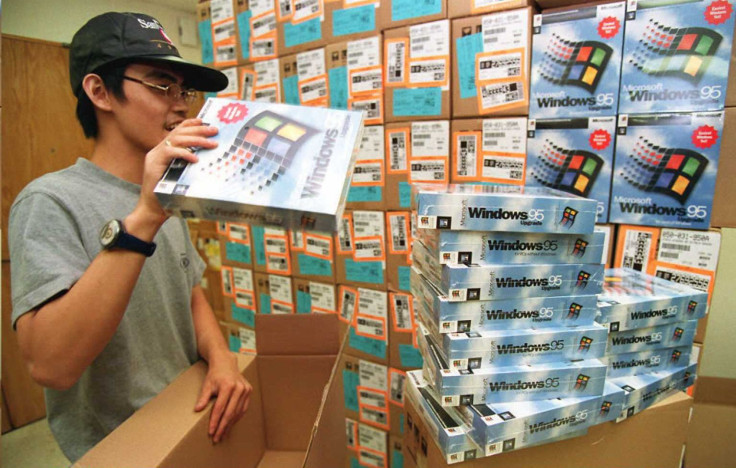Microsoft Windows Is 30: A Short History Of One Of The Most Iconic Tech Products Ever

On November 20, 1985, Windows was unleashed to the world. In the 30 years since, it's had an incredible impact on computing, and the world in general. Today, Windows commands over 90 percent of desktop marketshare, a lead it's held throughout the personal computing revolution.
Humble Beginnings
Windows 1.0 was the first graphical interface for MS-DOS, the older command line-based operating system Microsoft introduced for IBM PCs in 1981. The system requirements pale in comparison to today: Windows 1.0 needed 256KB of memory to run, and 512KB was recommended for having multiple programs running. Windows 10, on the other hand, needs 1GB of memory for the 32-bit version. Today, Windows needs almost 4,000 times more memory to function than it did 30 years ago.
Windows 2.0, which launched in 1987, and Windows 3.0, which launched in 1990, made improvements to the very basic (by today's standards) offerings of Windows 1.0. But it wasn't until Windows 95, almost 10 years after the first launch of Windows 1.0, that things really started to take off.
Windows 95 was a big change. It ditched the program manager in favor of a new start menu, supported the internet, and had new plug-and-play support for easy hardware installation. Windows 98, 98 Second Edition, and Millennium Edition built on these basic beginnings, improving support for the internet and developing multimedia support.
Leading A Double Life
But there was a second operating system in development side-by-side. Windows NT was a new system, designed for the modern era, that ditched MS-DOS dependence and introduced forward-looking under-the-hood features. Launched in 1993, NT was aimed at businesses, with the existing line of Windows products intended for consumers. It wouldn't be until the turn of the millennium that Microsoft would merge the two together.
Windows XP is remembered by many as one of the most iconic versions of Windows. Launched in October 2001, the release finally merged the consumer and professional lines of Windows into one NT-based operating system. A bold new visual style, Luna, ditched the grey of old Windows interfaces and replaced it with a bright color palette that competed with Mac OS X (which launched in March 2001).
In the first five years of availability, Windows XP sold 400 million copies. Even today XP is used around the world. The October 2015 Netmarketshare figures show Windows XP is installed on 11.68 percent of computers worldwide, 14 years after its release.
No Clear Way Forward
The next entry in the series is not exactly remembered for its success. Longhorn, as it was known throughout most of its development, was intended as a stopgap release between Windows XP and a future version codenamed Blackcomb. But Longhorn grew and grew in size; at one point, Microsoft started all over again because it was clear nobody knew what the plan was. The eventual Windows Vista launch was the longest timespan between releases, with its January 2007 launch marking the end of a $6 billion development journey.
But it was Microsoft's biggest flop. Today, Vista holds just 1.7 percent of the market.
It wouldn't hold Microsoft back for long, though. Vista served as an ideal stepping stone towards Windows 7, with many of the major core changes introduced in Vista (like a totally rewritten audio stack) providing the basis for Windows 7. Less than two years after its October 2009 launch, Windows 7 had sold 450 million copies, and today the majority of the world's computers run Windows 7.
The Tablet Era
The next version of Windows would focus on providing an answer for the new tablet PC phenomenon. The iPhone launch in 2007 and iPad launch in 2010 had changed the computing landscape. Consumers wanted touchscreens, app stores, and straightforward interfaces, all three of which the next version of Windows would seek to address. Spearheaded by Steve Sinofsky, Windows 8 was a bold move towards a single interface across all devices, dropping features that had existed since Windows 95 like the start menu.
It didn't work. Although it matched Windows 8 sales in the first six months, enterprises said they would skip it. Microsoft was forced to backtrack on some of the more radical changes with Windows 8.1. The update was free to Windows 8 users and was distributed through the Windows store. Today, Windows 8.1 is the third-most used operating system in the world.
The Last Version Of Windows
In the same year of Windows' 30th anniversary, Microsoft released what it would refer to as the last ever version of Windows. That was a slight mischaracterization of the company's plan. Instead of releasing a new version of Windows every few years, there would be regular updates sent through the Windows update system. Microsoft worked tirelessly to move Windows to a more modular design, so key components could be updated through internet downloads.
It is not clear why there was never a Windows 9. Microsoft has made subtle jokes about skipping the version, but never definitively explained why. An rumor suggests that poor coding meant older programs would be fooled into thinking that Windows 9 was a lot older than it actually was, as the system would check to see if the OS name started with "Windows 9" (to see if it was either Windows 95 or 98).
Whatever the reasoning, Windows 10 launched in July and began to rapidly catch up with its predecessors. The refined user interface, compared to Windows 8, finally merged tablet and desktop interfaces in a way that made more sense. Today, it holds 7.94 percent of the market and growing. The company has big plans for future updates, with the next set, "Redstone," scheduled to roll out next year.
© Copyright IBTimes 2024. All rights reserved.






















